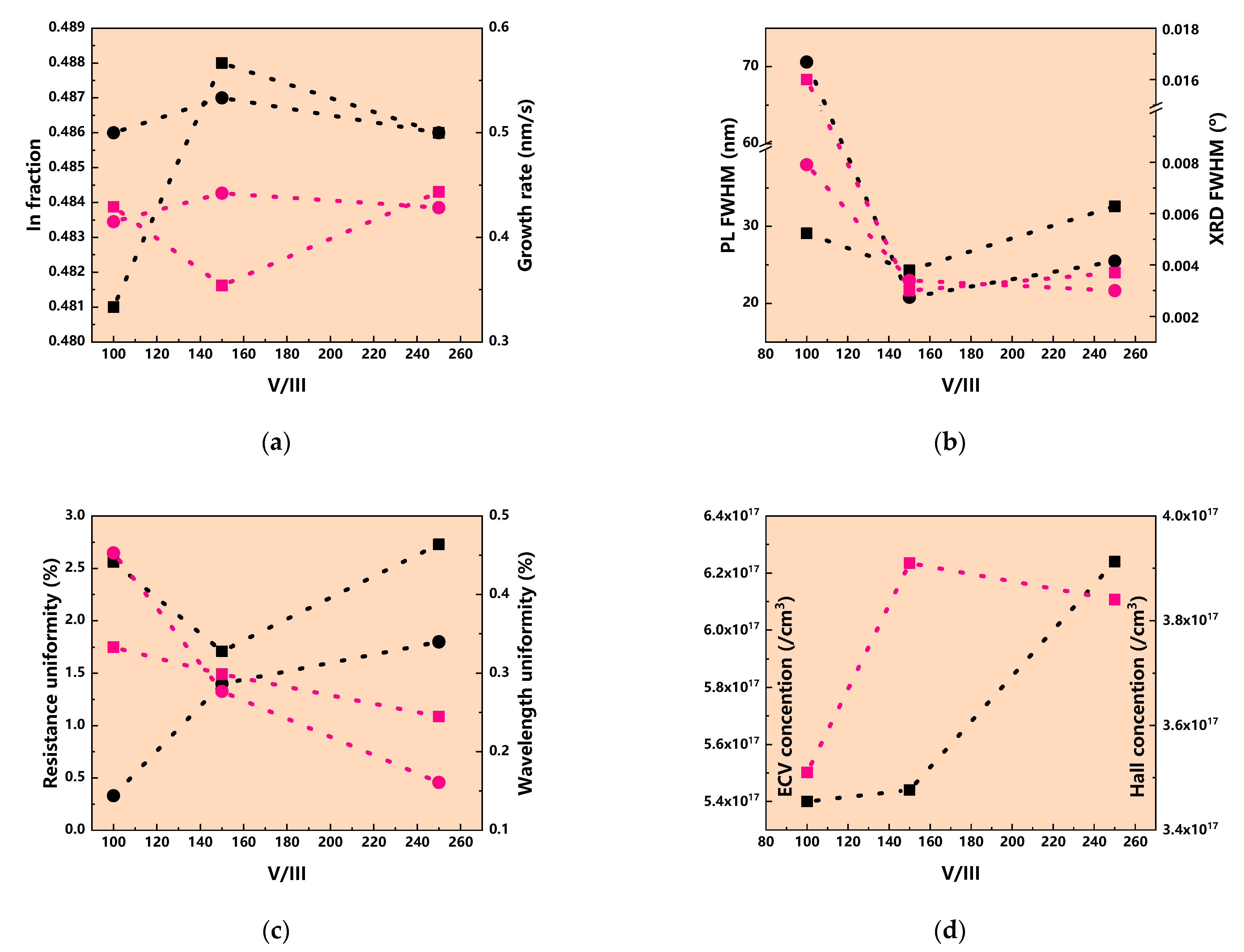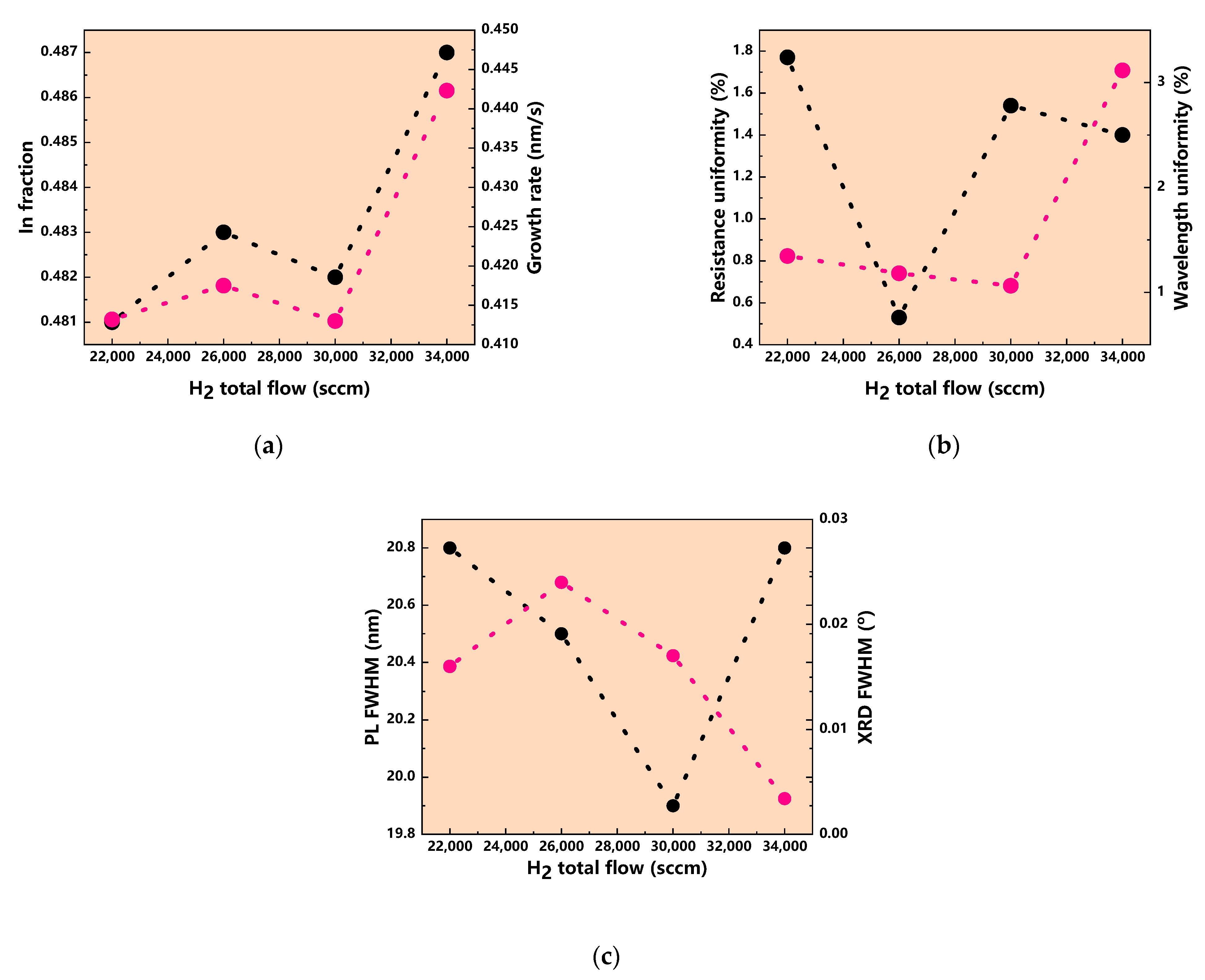High Uniformity 6-Inch InGaP Epitaxial Growth
Abstract
:1. Introduction
2. Materials and Methods
3. Results
3.1. The Influence of Growth Temperature
3.2. The Influence of the V/III Ratio
3.3. The Influence of H2 Total Flow
3.4. Discussion
4. Conclusions
Author Contributions
Funding
Data Availability Statement
Conflicts of Interest
References
- Ju, I.; Lee, S.; Cressler, J.D. An Efficient, Broadband SiGe HBT Non-Uniform Distributed Power Amplifier Leveraging a Compact, Two-Section λ/4 Output I\mpedance Transformer. IEEE Trans. Microw. Theory Tech. 2022, 70, 3524–3533. [Google Scholar] [CrossRef]
- Kopytko, M.; Rogalski, A. Figure of Merit for Infrared Detector Materials. Infrared Phys. Technol. 2022, 122, 104063. [Google Scholar] [CrossRef]
- Sun, T.; Yang, K.; Wei, J.; Jia, Y.; Deng, S.; Zhao, Z.; Zhang, B.; Luo, X. High-Voltage Polarization-Superjunction GaN HEMT With Built-In SBD for Low Reverse Conduction Loss. IEEE J. Electron Devices Soc. 2022, 10, 808–812. [Google Scholar] [CrossRef]
- Pan, G.; Xun, M.; Sun, Y.; Zhao, Z.; Xu, C.; Xie, Y.; Wu, D.; Zhou, J. Two-Dimensional Coherent VCSEL Arrays with Configurable Beam Emissions. Opt. Laser Technol. 2022, 149, 107809. [Google Scholar] [CrossRef]
- Cho, I.-W.; Park, S.H.; Nguyen, T.T.; Kim, Y.; Lee, S.J.; Ryu, M.-Y. Effect of Tunnel Junction Grown at Different Growth Rates on the Optical Properties and Improved Efficiency of InGaP/GaAs Double-Junction Solar Cells. J. Alloys Compd. 2020, 832, 154989. [Google Scholar] [CrossRef]
- Gou, Y.; Wang, H.; Wang, J.; Yang, H.; Deng, G. High Performance P++-AlGaAs/N++-InGaP Tunnel Junctions for Ultra-High Concentration Photovoltaics. Optics Express 2022, 30, 23763. [Google Scholar] [CrossRef]
- Mao, Q.; Huang, L.; Xiang, Z.; Zhu, D.; Meng, J. High-Power Microwave Pulse Induced Failure on InGaP/GaAs Heterojunction Bipolar Transistor. Microelectron. Reliab. 2022, 139, 114848. [Google Scholar] [CrossRef]
- Sodabanlu, H.; Ubukata, A.; Watanabe, K.; Sugaya, T.; Nakano, Y.; Sugiyama, M. High-Speed MOVPE Growth of InGaP Solar Cells. IEEE J. Photovolt. 2020, 10, 480–486. [Google Scholar] [CrossRef]
- Ha, S.T.; Paniagua-Domínguez, R.; Kuznetsov, A.I. Room-Temperature Multi-Beam, Multi-Wavelength Bound States in the Continuum Laser. Adv. Opt. Mater. 2022, 10, 2200753. [Google Scholar] [CrossRef]
- Cho, I.-W.; Ryu, M.-Y.; Song, J.D. Temperature-Dependent Carrier Dynamics of InP/InGaP Quantum Structures Grown at Various Growth Temperatures Using Migration-Enhanced Epitaxy. J. Lumin. 2020, 223, 117214. [Google Scholar] [CrossRef]
- Peng, C.-Y.; Huang, W.-T.; Lu, Z.-K.; Chen, S.-C.; Kuo, H.-C. Design of High-Power Red VCSEL on a Removable Substrate. Photonics 2022, 9, 763. [Google Scholar] [CrossRef]
- Wang, L.; King, I.; Chen, P.; Bates, M.; Lunt, R.R. Epitaxial and Quasiepitaxial Growth of Halide Perovskites: New Routes to High End Optoelectronics. APL Mater. 2020, 8, 100904. [Google Scholar] [CrossRef]
- Gomyo, A.; Suzuki, T.; Kobayashi, K.; Kawata, S.; Hino, I.; Yuasa, T. Evidence for the Existence of an Ordered State in Ga0.5In0.5P Grown by Metalorganic Vapor Phase Epitaxy and Its Relation to Band-Gap Energy. Appl. Phys. Lett. 1987, 50, 673–675. [Google Scholar] [CrossRef]
- Sangiovanni, D.G.; Faccio, R.; Gueorguiev, G.K.; Kakanakova-Georgieva, A. Discovering Atomistic Pathways for Supply of Metal Atoms from Methyl-Based Precursors to Graphene Surface. Phys. Chem. Chem. Phys. 2023, 25, 829–837. [Google Scholar] [CrossRef]
- Kakanakova-Georgieva, A.; Ivanov, I.G.; Suwannaharn, N.; Hsu, C.-W.; Cora, I.; Pécz, B.; Giannazzo, F.; Sangiovanni, D.G.; Gueorguiev, G.K. MOCVD of AlN on Epitaxial Graphene at Extreme Temperatures. Catal. Sci. Technol. 2021, 23, 385–390. [Google Scholar] [CrossRef]
- Liu, Z.; Zhu, H.; Pan, X.; Huang, Y. Burn-in Effect in InGaP/GaAs HBT with Intrinsically or Extrinsically Carbon Doped Base Layer. Phys. Scr. 2023, 98, 065009. [Google Scholar] [CrossRef]
- Elhamri, S.; Ahoujja, M.; Newrock, R.S.; Mast, D.B.; Herbert, S.T.; Mitchel, W.C.; Razeghi, M. Electrical Properties of Undoped GaxIn1−xP/GaAs Quantum Wells. Phys. Rev. B 1996, 54, 10688–10695. [Google Scholar] [CrossRef]
- Heidelberger, C.; Fitzgerald, E.A. GaAsP/InGaP Heterojunction Bipolar Transistors Grown by MOCVD. J. Appl. Phys. 2017, 121, 045703. [Google Scholar] [CrossRef] [Green Version]
- Forghani, K.; Reddy, R.; Rowell, D.; Tatavarti, R. MOVPE Growth of AlInP–InGaP Distributed Bragg Reflectors. IEEE J. Photovolt. 2020, 10, 754–757. [Google Scholar] [CrossRef]
- Kınacı, B.; Özen, Y.; Kızılkaya, K.; Asar, T.; Çetin, S.Ş.; Boyalı, E.; Öztürk, M.K.; Memmedli, T.; Özçelik, S. Effect of Alloy Composition on Structural, Optical and Morphological Properties and Electrical Characteristics of GaxIn1−xP/GaAs Structure. J. Mater. Sci. Mater. Electron. 2013, 24, 1375–1381. [Google Scholar] [CrossRef]
- Attolini, G.; Bocchi, C.; Germini, F.; Pelosi, C.; Parisini, A.; Tarricone, L.; Kùdela, R.; Hasenohrl, S. Effects of Inhomogeneities and Ordering in InGaP/GaAs System Grown by MOVPE. Mater. Chem. Phys. 2000, 66, 246–252. [Google Scholar] [CrossRef]
- Pitts, O.J.; Benyon, W.; SpringThorpe, A.J. Modeling and Process Control of MOCVD Growth of InAlGaAs MQW Structures on InP. J. Cryst. Growth 2014, 393, 81–84. [Google Scholar] [CrossRef]
- Jakomin, R.; Parisini, A.; Tarricone, L.; Longo, M.; Fraboni, B.; Vantaggio, S. On the Electrical Properties of Si-Doped InGaP Layers Grown by Low Pressure-metalorganic Vapor Phase Epitaxy. Thin Solid Film. 2012, 520, 6619–6625. [Google Scholar] [CrossRef]
- Hageman, P.R.; van Geelen, A.; Gabriëlse, W.; Bauhuis, G.J.; Giling, L.J. Optical and Electrical Quality of InGaP Grown on GaAs with Low Pressure Metalorganic Chemical Vapour Deposition. J. Cryst. Growth 1992, 125, 336–346. [Google Scholar] [CrossRef]
- Martín, G.; Coll, C.; López-Conesa, L.; Rebled, J.M.; Barrigón, E.; García, I.; Rey-Stolle, I.; Algora, C.; Cornet, A.; Estradé, S.; et al. Understanding the Anisotropy in the Electrical Conductivity of CuPt B -Type Ordered GaInP Thin Films by Combining In Situ TEM Biasing and First Principles Calculations. ACS Appl. Electron. Mater. 2022, 4, 3478–3485. [Google Scholar] [CrossRef]



| No. | Growth Temperature | V/III | Si2H6 Flow |
|---|---|---|---|
| 1 | 580 °C | 250 | 0 sccm |
| 2 | 600 °C | 250 | 0 sccm |
| 3 | 650 °C | 250 | 0 sccm |
| 4 | 580 °C | 100 | 0 sccm |
| 5 | 600 °C | 100 | 0 sccm |
| 6 | 650 °C | 100 | 0 sccm |
| 7 | 580 °C | 100 | 1.3 sccm |
| 8 | 600 °C | 100 | 1.3 sccm |
| 9 | 650 °C | 100 | 1.3 sccm |
| No. | Growth Temperature | V/III | Si2H6 Flow |
|---|---|---|---|
| 10 | 600 °C | 100 | 0 sccm |
| 11 | 600 °C | 150 | 0 sccm |
| 12 | 600 °C | 250 | 0 sccm |
| 13 | 650 °C | 100 | 0 sccm |
| 14 | 650 °C | 150 | 0 sccm |
| 15 | 650 °C | 250 | 0 sccm |
| 16 | 650 °C | 100 | 1.3 sccm |
| 17 | 650 °C | 150 | 1.3 sccm |
| 18 | 650 °C | 250 | 1.3 sccm |
| No. | H2 Total Flow | Growth Temperature | V/III |
|---|---|---|---|
| 19 | 34,000 sccm | 600 °C | 150 |
| 20 | 30,000 sccm | 600 °C | 150 |
| 21 | 26,000 sccm | 600 °C | 150 |
| 22 | 22,000 sccm | 600 °C | 150 |
Disclaimer/Publisher’s Note: The statements, opinions and data contained in all publications are solely those of the individual author(s) and contributor(s) and not of MDPI and/or the editor(s). MDPI and/or the editor(s) disclaim responsibility for any injury to people or property resulting from any ideas, methods, instructions or products referred to in the content. |
© 2023 by the authors. Licensee MDPI, Basel, Switzerland. This article is an open access article distributed under the terms and conditions of the Creative Commons Attribution (CC BY) license (https://creativecommons.org/licenses/by/4.0/).
Share and Cite
Yang, S.; Guo, N.; Pei, Y.; Yuan, W.; Li, Y.; Zhao, S.; Zhang, Y.; Liu, X. High Uniformity 6-Inch InGaP Epitaxial Growth. Crystals 2023, 13, 1165. https://doi.org/10.3390/cryst13081165
Yang S, Guo N, Pei Y, Yuan W, Li Y, Zhao S, Zhang Y, Liu X. High Uniformity 6-Inch InGaP Epitaxial Growth. Crystals. 2023; 13(8):1165. https://doi.org/10.3390/cryst13081165
Chicago/Turabian StyleYang, Shangyu, Ning Guo, Yicheng Pei, Weilong Yuan, Yunkai Li, Siqi Zhao, Yang Zhang, and Xingfang Liu. 2023. "High Uniformity 6-Inch InGaP Epitaxial Growth" Crystals 13, no. 8: 1165. https://doi.org/10.3390/cryst13081165






